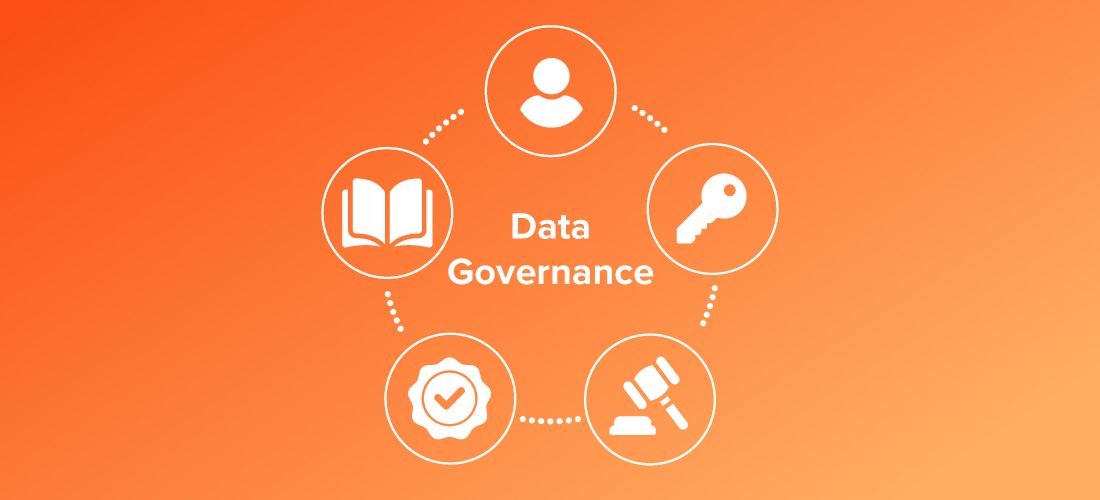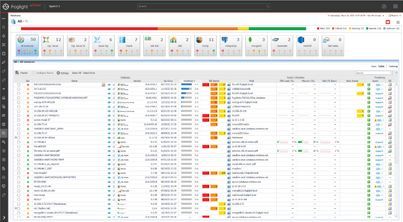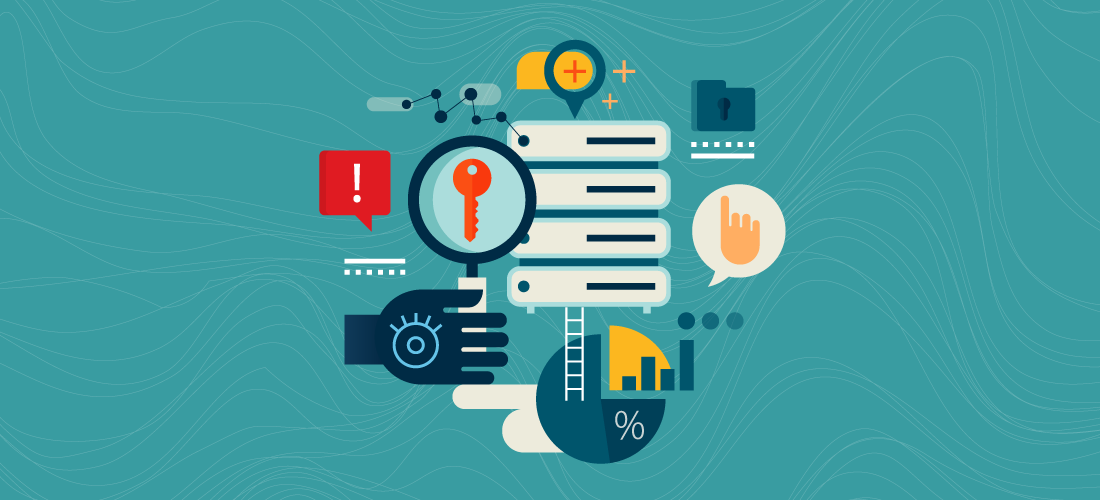
In many organizations, data governance has become associated with limiting access to data, which makes the ROI and benefits of data governance a harder sell. In reality, data governance is about much more than telling people what they cannot do with data. When put into action as a framework for reducing risk and optimizing opportunities, the benefits of data governance include greater efficiency, better compliance and better decision making. For organizations looking to effectively democratize data, embracing this expanded view of data governance is a critical lynchpin for assuring the success of a truly data-driven enterprise.
What is the goal of data governance?
The primary purpose of data governance is to uphold high data quality throughout the entire data lifecycle and to align implemented controls with the organization’s business objectives. Ensuring effective and efficient use of information in accordance with the company’s intentions is crucial. Data governance specifies who can take specific actions based on certain data, under what circumstances, and using prescribed methods.
Why data governance is important?
The majority of large corporations possess data silos housing inconsistent data, inaccessible to users across the organization. Aligning data collection, creation, classification, formatting and usage across organizational boundaries requires a lot of effort. As a result, data governance has become one of the core elements of an overall data management strategy.
Benefits on both sides of the data governance coin
Data governance is perceived differently depending on your position in a company, but there’s more to it than just rules about what organizations can or can’t do with data.
On one side of the coin, the benefits of data governance lie in reducing data-related risk in areas like privacy security and ensuring data quality. On the other side, they lie in optimizing opportunities by increasing data literacy and improving how you deliver data to the organization.
Reducing data-related risk
The first area of risk reduction is in privacy security and protecting data. That relates to:
- Compliance
- Cyberattacks
- Knowing where your data is
- Knowing which data is at risk and is attractive to threat actors
- Understanding where your data is vulnerable externally (and internally, because many data problems are rooted in the organization itself)
Data governance can be as straightforward as disabling USB ports to prevent inadvertent data leakage through thumb drives. Protecting data from that avenue of escape is a classic example of reducing risk through data governance.
The second area is in ensuring the quality of the data. That starts with defining quality for your organization, then tracking it as a score and continually monitoring whether it is rising or falling. It also entails making everybody aware of the quality of specific data sources and allowing decision makers to take that quality into account as they use the data. When users are aware of specific deficiencies, they can make intelligent, informed decisions on how to use the data. Ensuring quality through data governance also helps you avoid feeding flawed data into expensive analytics engines and basing decisions on flawed results.
Optimizing opportunities
Data governance benefits the creation of opportunities by increasing data literacy across the organization. When an organization is more data-literate, you can use data intelligently because you understand where it came from, whether it’s been transformed or degraded and how it relates to the business. In other words, you use your data more effectively.
Data literacy supports innovation and ideation around using data for the benefit of the organization. Having an awareness of the data landscape allows you to combine data sources and find previously hidden patterns and answers. When data-related opportunities arise, the benefits of data governance can shorten your time to value and help you differentiate yourself from your competitors.
That way, you increase the thirst for data and you deliver data more efficiently. That applies whether you’re deploying new data, making business-required changes to existing data or distributing the data to decision makers in the business.
In fact, an unexpected benefit of data governance is that it becomes a foundation for automation opportunities. Imagine making the changes to your data and then having your tools deploy those changes and update the data as required, reducing latency in access to that new or changed data. The entire life cycle of your data becomes centrally managed and centrally aware. In some organizations, that could take the form of AI or machine learning capabilities; in others, it could be more prescriptive, such as automating the implementation of new data.
The classic benefits of data governance
More concretely, the traditional benefits of data governance break down as follows:
Greater efficiency
Data governance helps IT work more efficiently because it gives them more insight into organizational data: how and where it’s stored and the path it has taken. They can be much more efficient at adding new data or changing the way data is managed, stored and made available.
Data stewards, who are responsible for data governance, also enjoy greater efficiency. The data intelligence they create for an organization also lets them guard against data slipping through the cracks. They can see from data lifecycles and the changes IT is making that new data is on the way. They can ensure that the appropriate connections, policies and literacy components are in place so that, on day one, governance reflects the reality of data.
Finally, the biggest impact of efficiency is in reducing the time from idea to insight for the wider business community. Consider an hour wasted by a single user struggling to find and understand the data to pursue a growth opportunity — then scale that out to hundreds of users. Even when data governance reduces wasted time by only 15 minutes, the impact across an organization can be huge.
Better data quality and consistency
Data quality has traditionally landed in the purview of IT, where function and rules are more important than the business impact or context of the data. IT knows, for example, that data in a given field should be no more than 40 characters long, or it should be a numeric field with three decimal points of accuracy. But IT doesn’t know when the data isn’t correct.
In that context, data governance is an exercise in exposing and monitoring the level of quality, communicating it, and enabling day-to-day users to improve on it. Not only can they work with the data more efficiently, but they can also better evaluate it. Users can work beyond the rules of IT by saying, “This data doesn’t reflect what’s on the transactional side. What’s happened to it? Why is it being degraded? Can we change that?”
The more collaboration you have around quality, the higher the quality of your data will be over time.
Better compliance
If you don’t know what you have, how can you manage it and remain in compliance?
Most people understand privacy within a specific data set. But data governance extends privacy – on personally identifiable information (PII), to the company’s intellectual property, to sensitive data, etc. – all the way back to the source of the data. Data can fall out of the privacy path before organizational users realize that they’re putting the company at risk.
Better compliance and better armor against cyberattacks start with deep insight into organizational data and the realization that not all data is created equal. Some data is more attractive than others to threat actors. Some types of data are more closely associated with risk than others, when it comes to managing and maintaining data in the organization.
Improved business planning
A big benefit of data governance is the holistic picture of the idea that data is an asset of the business. That picture is the backdrop of better business planning.
You can start that improved business planning around your compliance schemes, then use the big picture to figure out:
- How data flows
- Where the bottlenecks lie
- Where the problems are
- How you can solve those problems
- Where your infrastructure is bloated
Your planning may turn toward simplifying your data landscape and consolidating on the cloud.
Better decision making
Most organizations are still trying to establish a data-driven culture in which data quality is a top priority. An artifact of that effort is low trust in data, and when people don’t trust their data, they generally won’t use it to its full potential.
What’s your first impulse when somebody makes a radical suggestion based on data? Most people would reply, “Where did that data come from? Explain that data and how you came to this conclusion.” Without data governance and data intelligence, it’s easy to make claims based on data, but far harder to convince anyone else that data is accurate. You end up with a culture of “Let me get back to you on that.”
Better decision making is a benefit of data governance that comes from being able to trust and explain data. Only a strong foundation of data insights will get risk-averse stakeholders to take a chance on an opportunity. Decision making gets better when people trust the data and the insights that come from it.
Enhanced business reputation
Strong data governance can reduce the risk to your business reputation, so much so that being a reliable custodian of personal data has become a value proposition. People don’t like the prospect of having their ID, finances and PII compromised; that’s why data privacy, as part of data governance, can affect decisions about the organizations individuals will do business with.
One benefit of data governance is being able to quickly determine the extent of a data breach, should one befall your organization. In that event, knowing the extent of what data was compromised and whose data was breached allows organizations to be up front about the overall impact.
Improving financial performance and maximizing profits of the company
The financial benefits of data governance are interwoven. With granular insight into your business come more levers you can pull to improve financial performance. When you squeeze costs out of the process of getting things done, profits will rise. You’ll become more competitive because you can back your market moves with data.
Why do companies hesitate to implement data governance?
Often, the hesitation boils down to priorities which, in recent years, have been dominated by analytics, AI, machine learning and data science. Those priorities attract companies to focus on processing data for insight but distract them from investing in getting their data house in order. It’s useful to build an up-to-date arsenal of those tools, but much more useful when the tools are processing well-governed data.
Many IT teams face the same trade-off between data governance and cloud computing. They recognize the importance of the former but see the latter as an easier sell to management and a shorter path to ROI.
Another hindrance is that, as mentioned above, data governance still has some lingering baggage. Early data governance programs felt to most users like a long series of stop signs – “You can’t do that.” “You can’t have access.” “Prove you need access.” – arranged to keep users from accomplishing anything with data. Before the benefits of data governance were clearly demonstrated, most people treated it like an obstacle to be circumvented.
Governance for the good
Enter data governance for the good, or being smart about your governance.
Most companies start with compliance because that’s the elephant in the room. However, compliance is table stakes. It’s possible to implement data governance in a way that that focuses on both risk mitigation and opportunity without feeling like a long set of roadblocks. At that point it’s possible to put the right measures in place to sell data governance to the company.
One of the main reasons for many data-governance hesitations is that organizations have a big mess of poorly mapped, poorly trusted data to clean up. And you’re trying to figure out how to approach it. Consider the IT managers who want to modernize their data landscape and democratize data. They’re busy making decisions about data meshes, data fabrics, data lakes and control planes.

Maximize the business impact of your data
The problem, however, is that none of those options will be successful in the long term without data governance. All of them will have a more profound effect on ROI if data governance is in place first and woven into the whole plan.
Conclusion
For years, the conventional wisdom has been that data governance is everybody’s business. That wisdom only sifts down to the day-to-day users of data when the benefits of data governance are clearly demonstrated and conveyed. The biggest benefit of data governance is that people in different positions across the organization can come together and make informed decisions.
Naturally, if data governance is as much work as – or more work than – the problem you’re trying to solve, then you’re doing it wrong. If your implementation of data governance requires 40 or 50 dedicated employees all day every day, it won’t fly.
Organizations that realize the role of data, the risk of data, and emphasize the benefits of data governance can enjoy the enhanced insights that come from properly managed data.



